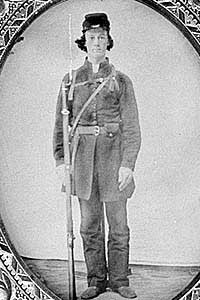At the onset of the American Civil War, the visual distinction between the Union and Confederate armies wasn’t as clear-cut as the iconic blue versus gray imagery we often associate with the conflict. Uniforms in the early days of the war were a diverse mix, reflecting the varied origins and preparedness of the hastily assembled troops. Understanding the evolution of Union Civil War Uniforms and their Confederate counterparts reveals fascinating insights into the logistical challenges and evolving identities of the fighting forces.
Initially, many soldiers on both sides simply wore clothing they brought from home. Adding to the complexity, local militia units, which formed the backbone of the early armies, often arrived in their pre-existing uniforms. This led to instances of Union soldiers clad in gray and Confederates in blue, creating potential for confusion on the battlefield. Further adding to the sartorial melting pot, some units, inspired by the French Zouaves of North Africa, adopted flamboyant uniforms featuring baggy, brightly colored trousers – often red or striped – paired with fez hats or turbans.
 Confederate Uniform
Confederate Uniform
Despite this initial variety, a degree of standardization soon emerged, particularly for the Union Army. Regular U.S. Army soldiers maintained their traditional uniforms of dark blue trousers, jackets, and kepi caps. To differentiate the burgeoning volunteer forces from these regulars, union civil war uniforms for volunteers were established. These volunteer soldiers were issued dark blue jackets and kepis, but notably, they were distinguished by light blue trousers. This subtle yet important variation helped to visually categorize the different branches within the Union ranks.
Confederate uniforms, in contrast, were primarily characterized by gray across all uniform components: kepi, jacket, and trousers. However, the color of Confederate uniforms was not static. As the war progressed and uniforms endured the elements, the gray cloth often faded and weathered, acquiring a light brownish hue. This shift in color gave rise to the nickname “Butternuts” for Confederate soldiers, referencing the butternut squash. It is also believed that “butternut” brown clothing may have resulted from the use of natural dyes in homespun uniforms, reflecting the Confederacy’s resource constraints and reliance on local production.
Beyond the basic infantry uniforms, specific branches were denoted by color variations. Artillerymen on both sides were identifiable by red. This color was prominently featured on their kepis, shell jackets (as trim), and, depending on rank, as a stripe on their trouser legs. Cavalry units, similarly, had their distinctive color: yellow. Yellow striping on trousers and yellow trim on jackets marked cavalry riders in both the Union and Confederate armies.
While blue and gray became the predominant colors of the opposing armies, it’s important to remember the existence of specialized units with unique uniforms. Perhaps the most well-known example is Hiram Berdan’s Union sharpshooters, famed for their distinctive green uniforms. These green uniforms provided camouflage, a tactical advantage for sharpshooters operating in skirmish lines and wooded areas. However, these specialized uniforms remained exceptions, with blue and gray firmly establishing themselves as the visual identifiers of the Union and Confederate forces respectively.
The materials used in union civil war uniforms and Confederate clothing also differed, reflecting the industrial and agricultural strengths of the North and South. Thanks to the cotton production of the Southern states, Confederate uniforms were often made of cotton cloth. In contrast, the North primarily utilized wool for union civil war uniforms. Wool offered advantages in terms of durability and temperature regulation, providing warmth in winter and relative coolness in summer, especially when a breeze was present.
Regardless of the initial quality and intended design, the harsh realities of campaigning took a significant toll on soldiers’ attire on both sides. Clothing and shoes wore out rapidly under the stress of marches, battles, and exposure to the elements. While the image of the “rag-tag, barefoot Confederate” is a persistent symbol of the Civil War, it’s crucial to recognize that Union soldiers also faced similar hardships. At various points throughout the war, Union troops could also be found in threadbare uniforms and even barefoot, highlighting the shared struggles of soldiers on both sides in maintaining adequate supplies under wartime conditions.
In conclusion, while the Civil War is often visualized in stark contrasts of blue and gray, the reality of union civil war uniforms and Confederate attire was more nuanced. From the initial chaos of diverse militia uniforms to the eventual standardization of blue for the Union and gray for the Confederacy, the uniforms of the Civil War armies reflect the evolving nature of the conflict and the practical demands of equipping and sustaining massive armies in the field.
